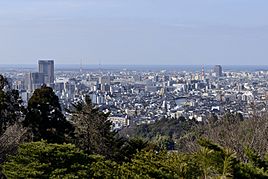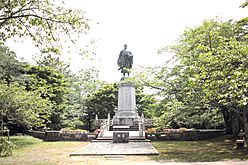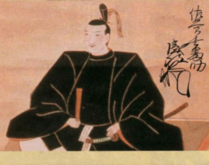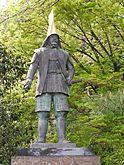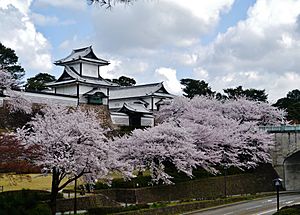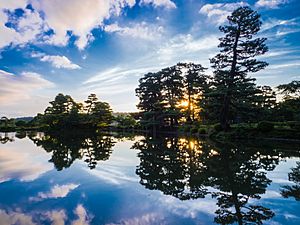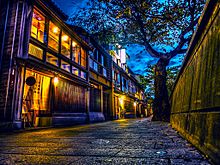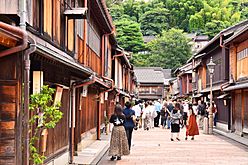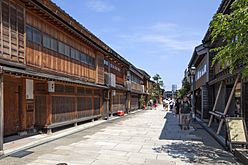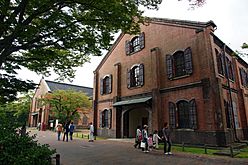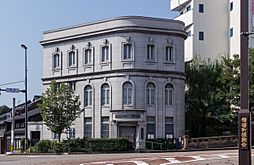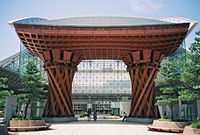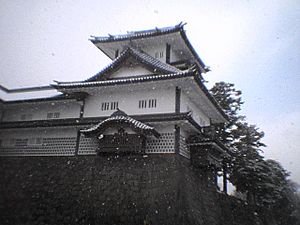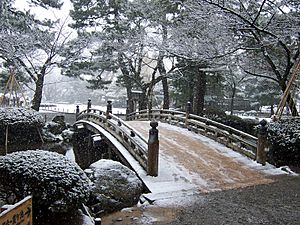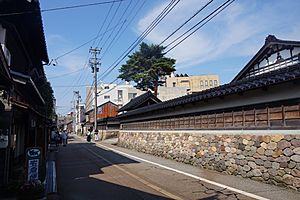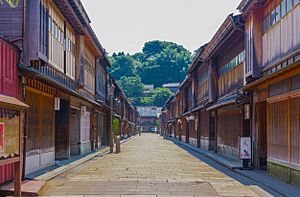Kanazawa facts for kids
Quick facts for kids
Kanazawa
金沢市
|
|||||||||
|---|---|---|---|---|---|---|---|---|---|
|
|||||||||
|
|||||||||
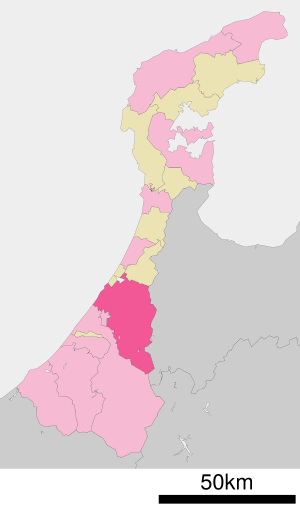
Location of Kanazawa in Ishikawa Prefecture
|
|||||||||
| Country | Japan | ||||||||
| Region | Chūbu (Hokuriku) | ||||||||
| Prefecture | Ishikawa Prefecture | ||||||||
| Area | |||||||||
| • Total | 468.64 km2 (180.94 sq mi) | ||||||||
| Population | |||||||||
| • Total | 466,029 | ||||||||
| • Density | 994.429/km2 (2,575.558/sq mi) | ||||||||
| Time zone | UTC+09:00 (Japan Standard Time) | ||||||||
| City symbols | |||||||||
| Tree | Prunus mume | ||||||||
| Flower | Iris Salvia splendens Begonia Impatiens walleriana Pelargonium |
||||||||
| Phone number | 076-220-2111 | ||||||||
| Address | 1-1-1 Hirozaka, Kanazawa-shi, Ishikawa-ken 920-8577 | ||||||||
Kanazawa (金沢市, Kanazawa-shi) is a cool city in central Japan. It's the capital of Ishikawa Prefecture. As of 2018, about 466,029 people lived here. The city covers an area of about 468 square kilometers.
Contents
What's in a Name?
The name "Kanazawa" (金沢) means "marsh of gold." It comes from an old story about a farmer named Imohori Togoro. He was digging for potatoes when he found flakes of gold washing up from the ground!
A well in the famous Kenroku-en garden is called 'Kinjo Reitaku'. This name remembers the legend of the gold. The area was first known as Ishiura, and you can still find that name at the Ishiura Shrine. Kanazawa was once part of an old region called Kaga Province.
Kanazawa's Past
Early Days: The Muromachi Period
During the Muromachi period (1336 to 1573), the central government in Kyoto became weaker. Kaga Province, where Kanazawa is, was taken over by a group called the Ikkō-ikki. These were followers of a Buddhist priest named Rennyo.
They kicked out the local governors and created their own kind of government, sometimes called "The Peasants' Kingdom." Their main base was the Kanazawa Gobo. It was a natural fortress, protected by hills and rivers. A town grew around this fortress, which was the beginning of Kanazawa.
Warring States: The Sengoku Period
In 1580, during the Sengoku period (1467 to 1615), a powerful leader named Oda Nobunaga sent his generals to conquer the Ikkō-ikki. After they won, the area was given to Maeda Toshiie. He then started the Kaga Domain.
Maeda Toshiie supported Tokugawa Ieyasu in a big battle in 1600. Because of this, his land grew much larger. The Maeda clan ruled Kaga Domain from Kanazawa Castle for a very long time, until the end of the Edo period.
Growing into a Big City: The Edo Period
Maeda Toshiie and the leaders who came after him made Kanazawa Castle much bigger. They also carefully planned the city around it for defense. In 1631, a large fire burned much of the city, including the castle.
To help with water shortages, a canal was built in 1632. It brought water from the Sai River to the castle. The large lake in Kenroku-en, called Kasumi-ga-Ike, also served as an emergency water supply.
Before the Maeda clan arrived, Kanazawa had only about 5,000 people. But it grew very fast! By 1700, Kanazawa had over 100,000 people. It was as big as cities like Rome or Amsterdam at that time.
The Maeda leaders invited samurai, artisans, and merchants to live in Kanazawa. They offered special benefits to attract skilled workers. This helped the city's economy grow. Even ordinary people moved to Kanazawa for new opportunities. The city government also helped by building projects like the Sai River Project, which created more land for people to live on.
Kanazawa became rich because the leaders and the townspeople helped each other. The samurai needed goods and services, and the townspeople thrived because the leaders protected them. Kanazawa's growth was part of a bigger trend in Japan called urbanization, where more people moved to cities.
The Maeda clan used their great wealth to support arts and crafts instead of just military things. Kanazawa became famous for its "Million-koku Culture." This helped show the government that the domain was peaceful. Kanazawa was one of Japan's biggest cities throughout the Edo period.
Modern Times: The Meiji and Heisei Periods
After the Meiji restoration, the modern city of Kanazawa was officially created on April 1, 1889. The city's size grew over time as it added nearby towns and villages.
On April 1, 1996, Kanazawa became a Core city. This means it gained more control over its own local government.
Where is Kanazawa?
Kanazawa is in the northwest part of Ishikawa Prefecture in Japan's Hokuriku region. It has the Sea of Japan to its west and Toyama Prefecture to its east. The city is located between the Sai and Asano rivers. The eastern part of the city has mountains from the Japanese Alps. Some parts of Kanazawa are even inside the Hakusan National Park.
Kanazawa's Weather
Kanazawa has a humid subtropical climate. This means it has hot, humid summers and cold winters with lots of snow. It's a very wet city, with rain or snow on about 193 days a year. The most rain falls in autumn and winter.
| Climate data for Kanazawa (1991−2020 normals, extremes 1882−present) | |||||||||||||
|---|---|---|---|---|---|---|---|---|---|---|---|---|---|
| Month | Jan | Feb | Mar | Apr | May | Jun | Jul | Aug | Sep | Oct | Nov | Dec | Year |
| Record high °C (°F) | 21.2 (70.2) |
23.6 (74.5) |
27.1 (80.8) |
31.6 (88.9) |
33.7 (92.7) |
36.1 (97.0) |
37.4 (99.3) |
38.3 (100.9) |
38.5 (101.3) |
33.1 (91.6) |
28.4 (83.1) |
24.7 (76.5) |
38.5 (101.3) |
| Mean daily maximum °C (°F) | 7.1 (44.8) |
7.8 (46.0) |
11.6 (52.9) |
17.3 (63.1) |
22.3 (72.1) |
25.6 (78.1) |
29.5 (85.1) |
31.3 (88.3) |
27.2 (81.0) |
21.8 (71.2) |
15.9 (60.6) |
10.2 (50.4) |
19.0 (66.2) |
| Daily mean °C (°F) | 4.0 (39.2) |
4.2 (39.6) |
7.3 (45.1) |
12.6 (54.7) |
17.7 (63.9) |
21.6 (70.9) |
25.8 (78.4) |
27.3 (81.1) |
23.2 (73.8) |
17.6 (63.7) |
11.9 (53.4) |
6.8 (44.2) |
15.0 (59.0) |
| Mean daily minimum °C (°F) | 1.2 (34.2) |
1.0 (33.8) |
3.4 (38.1) |
8.2 (46.8) |
13.6 (56.5) |
18.4 (65.1) |
22.9 (73.2) |
24.1 (75.4) |
19.9 (67.8) |
13.9 (57.0) |
8.1 (46.6) |
3.5 (38.3) |
11.5 (52.7) |
| Record low °C (°F) | −9.7 (14.5) |
−9.4 (15.1) |
−8.3 (17.1) |
−1.6 (29.1) |
1.5 (34.7) |
6.8 (44.2) |
11.0 (51.8) |
13.1 (55.6) |
7.6 (45.7) |
2.2 (36.0) |
−0.7 (30.7) |
−6.7 (19.9) |
−9.7 (14.5) |
| Average precipitation mm (inches) | 256.0 (10.08) |
162.6 (6.40) |
157.2 (6.19) |
143.9 (5.67) |
138.0 (5.43) |
170.3 (6.70) |
233.4 (9.19) |
179.3 (7.06) |
231.9 (9.13) |
177.1 (6.97) |
250.8 (9.87) |
301.1 (11.85) |
2,401.5 (94.55) |
| Average snowfall cm (inches) | 67 (26) |
53 (21) |
13 (5.1) |
0 (0) |
0 (0) |
0 (0) |
0 (0) |
0 (0) |
0 (0) |
0 (0) |
1 (0.4) |
24 (9.4) |
157 (62) |
| Average precipitation days (≥ 0.5 mm) | 24.9 | 20.2 | 17.5 | 13.4 | 11.8 | 11.6 | 14.2 | 10.4 | 13.2 | 14.1 | 18.2 | 24.2 | 193.6 |
| Average relative humidity (%) | 74 | 70 | 66 | 64 | 67 | 74 | 75 | 72 | 73 | 70 | 70 | 72 | 70 |
| Mean monthly sunshine hours | 62.3 | 86.5 | 144.8 | 184.8 | 207.2 | 162.5 | 167.2 | 215.9 | 153.6 | 152.0 | 108.6 | 68.9 | 1,714.1 |
| Source: Japan Meteorological Agency | |||||||||||||
Nearby Cities and Towns
Kanazawa is surrounded by other cities and towns.
- Hakusan
- Nonoichi
- Tsubata
- Uchinada
- Oyabe
- Nanto
How Many People Live Here?
The number of people living in Kanazawa has grown a lot over time. Recently, the population has stayed about the same.
| Historical population | ||
|---|---|---|
| Year | Pop. | ±% |
| 1970 | 361,379 | — |
| 1980 | 417,684 | +15.6% |
| 1990 | 442,868 | +6.0% |
| 2000 | 456,638 | +3.1% |
| 2010 | 462,361 | +1.3% |
| 2020 | 463,254 | +0.2% |
Kanazawa's Sister Cities
Kanazawa has special friendships with cities around the world. These are called sister cities.
| City | Country | State | Since |
|---|---|---|---|
| Buffalo | New York | December 18, 1962 | |
| Porto Alegre | Rio Grande do Sul | March 20, 1967 | |
| Irkutsk | Irkutsk Oblast | March 20, 1967 | |
| Ghent | Flemish Region | October 4, 1971 | |
| Nancy | Grand Est | October 12, 1973 | |
| Suzhou | Jiangsu | June 13, 1981 | |
| Jeonju | Jeollabuk-do | April 30, 2002 |
What Does Kanazawa Do?
Kanazawa is an important center for business and transportation in Ishikawa Prefecture. It's also famous for its traditional crafts, like Kutani ware ceramics. Many people visit Kanazawa as tourists.
Learning in Kanazawa
Universities and Colleges
Kanazawa has several universities and colleges:
- Hokuriku Gakuin University
- Hokuriku University
- Kanazawa College of Art (run by the city)
- Kanazawa Gakuin College
- Kanazawa Gakuin University
- Kanazawa Seiryo University
- Kanazawa University (a large national university)
- Seiryo Women's Junior College
Schools for Younger Students
The city has many public elementary and middle schools. There are also some public and private high schools. Ishikawa Prefecture also runs special education schools in Kanazawa.
Getting Around Kanazawa
By Air
The closest airport is Komatsu Airport, located in the city of Komatsu.
By Train
Kanazawa is served by JR West and Hokuriku Railroad train lines. Since 2015, the Hokuriku Shinkansen (bullet train) connects Kanazawa to Tokyo. This makes the trip much faster, taking about 2.5 hours.
High-Speed Trains
- Hokuriku Shinkansen: - Kanazawa -
Local Train Lines
- Ishikawa Railway: Morimoto - Higashi-Kanazawa - Kanazawa - Nishi-Kanazawa
- Asanogawa Line: Hokutetsu-Kanazawa - Nanatsuya - Kamimoroe - Isobe - Waridashi - Mitsukuchi - Mitsuya - Okobata - Kitama - Kagatsume
- Ishikawa Line: Magae - Nuka-Jūtakumae - Otomaru - Shijima
By Road
Kanazawa has several major roads, including expressways and national routes.
Expressways
- Hokuriku Expressway
- Noto Satoyama Expressway
National Routes
 National Route 8
National Route 8 National Route 157
National Route 157 National Route 159
National Route 159 National Route 249
National Route 249 National Route 304
National Route 304 National Route 305
National Route 305 National Route 359
National Route 359
By Sea
Seaport
- Port of Kanazawa
Cool Places to See
Kanazawa was lucky because it wasn't destroyed by bombs during World War II. This means many of its old buildings and historic places are still standing today.
Kenrokuen Garden is the most famous spot in Kanazawa. It used to be the outer garden of Kanazawa Castle. It opened to the public in 1875. It's one of the "Three Great Gardens of Japan" and has many trees, ponds, waterfalls, and flowers. In winter, you can see special ropes called yukitsuri that support tree branches from heavy snow.
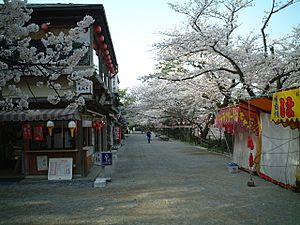
Near Kenrokuen is the Ishikawa-mon, which is a back gate to Kanazawa Castle. The original castle was mostly destroyed by fire in 1888, but parts of it have been rebuilt.
The Seisonkaku Villa was built in 1863 for a powerful lord's mother. It's a very elegant old house. You can see its brightly colored walls and special English carpet.
The Oyama-jinja shrine is also in Kanazawa. It has a unique three-story gate with colorful stained-glass windows, influenced by Dutch design.
Kanazawa's Myōryūji Temple, also known as the Ninja-dera (Ninja Temple), is famous for its hidden doors and secret passages. People say it was built as a secret hideout for the local rulers in case of danger.
Mount Utatsu offers amazing views of Kanazawa. You can find three shrines on the mountain: Toyokuni Shrine, Utatsu Shrine, and Atago Shrine. There's also a monument to the writer Shūsei Tokuda near the top.
Old Buildings and Streets
Kanazawa has many old Edo period (1603–1867) geisha houses in the Higashi Geisha District. This area feels like old Japan, with its two-story wooden buildings. The streets look especially beautiful in the early morning mist or at night with old-style streetlamps.
Houses in Kanazawa were taxed based on how wide they were at the front. This led to many long, thin houses. Merchant houses were built right up to the road. They often had a long hallway from the front door to the back, with rooms opening off it. At the very back, there was usually a strong, fireproof storage building.
Snow was a big factor in how houses were built. Roofs often sloped into a central garden to collect snow and let light into the back of the house. Traditional roofs used wooden boards held down by stones instead of heavy tiles, because of the heavy snowfalls.
Samurai Homes
In the 1600s, the areas where samurai lived were reorganized. The richest samurai lived in huge estates throughout the city. Even their servants lived in large complexes nearby. For example, the Honda family's servants lived in Honda-machi, which was almost like a town within a town.
Unlike in many other places, all samurai in Kaga, no matter how rich, lived in Kanazawa. By the late 1600s, over three-quarters of Kanazawa was samurai housing. The size and location of a samurai's house depended on their rank and income. Samurai homes usually had one floor and were surrounded by a garden. Their boundary walls were often made of packed earth with tiles on top. You can still see some of these walls in the Nagamachi area.
Temple Districts
One special thing about Kanazawa is how temples are grouped together near the city entrances. When the Ikkō-shū group ruled Kanazawa, all the temples belonged to their sect. After they were defeated, other Buddhist groups moved in. These temples were placed in their current spots around 1616.
In the Teramachi ("temple town") area, temples are lined up along a long, straight road. These large temples with thick walls could have been used as emergency forts, but this was never tested in Kanazawa. On the other side of town, the Utatsuyama temple district has smaller temples and winding roads.
Geisha Districts
Kanazawa grew even more in 1661. Many samurai returned to the city and built houses on the edges, with unplanned street layouts. These areas are now some of the most winding parts of the city.
A geisha house, or "tea house" (ochaya), looks a bit like a merchant house. However, the second floor of a tea house is much higher because it was used for entertaining guests. These upper floors have sliding wooden shutters that open during the day or for parties. The ground floor has special, fine wooden latticework called Kaga lattice. The decorations inside were very bright, using bold reds and blues, which was different from the more muted colors in Kyoto.
Kanazawa's Culture
The Hyakumangoku Matsuri and Asano-gawa Enyukai are the main festivals in Kanazawa.
Kanazawa-haku is gold that has been flattened into a very thin sheet, like paper. Gold leaf is a huge part of Kanazawa's traditional crafts. The city even has the Kanazawa Yasue Gold Leaf Museum. Kanazawa makes 99% of Japan's high-quality gold leaf. The famous Golden Pavilion in Kyoto is covered with gold leaf made in Kanazawa! Gold leaf is even used in food, like tea with gold flakes, which is thought to be good for health. Kanazawa lacquerware (Kanazawa shikki) is also well-known for its beautiful gold decorations.
The "Cultural landscape in Kanazawa. Tradition and culture in the castle town" has been recognized as an Important Cultural Landscape.
Delicious Local Food
Kanazawa is famous for its traditional Kaga Cuisine, especially seafood. The sake (Japanese rice wine) made here is also considered very good. This is because of the high-quality rice grown in Ishikawa Prefecture and the clean, fresh water from the region's heavy rainfall.
Omicho market is a lively market in the city center. It started in the Edo period and is now covered. Most of the shops sell fresh seafood.
Popular foods and drinks in Kanazawa include:
- Wagashi (Japanese sweets) of Kanazawa - These sweets are admired for how they appeal to all five senses.
- Jibuni - A soup dish with duck, vegetables, and wheat flour. It's a symbol of Kanazawa.
- Kanazawa Sake - Refined sake from the region.
- Kaga Vegetables - Special vegetables used in Kanazawa's traditional cooking.
- Kaburazushi - A traditional fermented dish that has been around since the Edo Era.
Famous People from Kanazawa
Politicians and Public Servants
- Nobuyuki Abe (a former Prime Minister of Japan)
- Senjūrō Hayashi (another former Prime Minister of Japan)
- Naoki Okada (a politician)
Business Leaders
- Takaaki Kidani (founder of Bushiroad)
- Shitagau Noguchi (founder of Nichitsu zaibatsu)
Scholars and Thinkers
- Hisashi Kimura (an astronomer)
- D. T. Suzuki (a famous scholar of Zen Buddhism)
- Yoshirō Taniguchi (an architect)
Artists and Writers
- Kyōka Izumi (a novelist)
- Natsuo Kirino (a novelist)
- Shūsei Tokuda (a novelist)
Media and Entertainers
- Azumi Inoue (a singer)
- Takeshi Kaga (an actor)
- Mamiko Noto (a voice actress)
- Aya Suzaki (a voice actress)
Sports Stars
- Kenkichi Oshima (Olympic bronze medalist in triple jump)
- Dejima Takeharu (a sumo wrestler)
- Enhō Akira (a sumo wrestler)
- Kaori Matsumoto (Olympic medalist in Judo)
Images for kids
See also
 In Spanish: Kanazawa para niños
In Spanish: Kanazawa para niños


